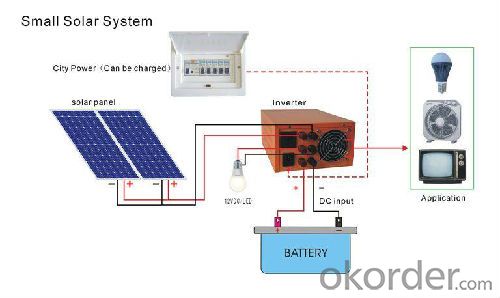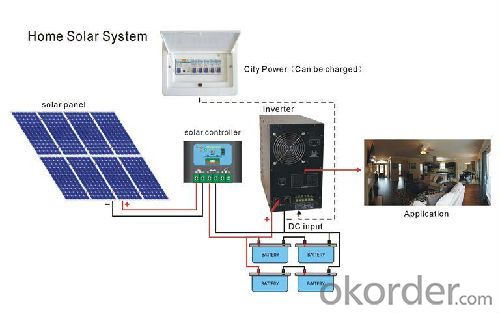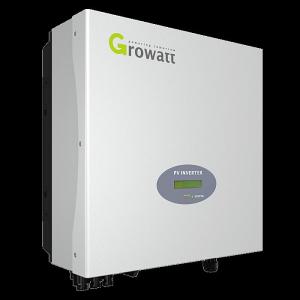Grid Tie Solar Inverters 10000TL All In One Low Maintenance Cost
- Loading Port:
- Shanghai
- Payment Terms:
- TT or LC
- Min Order Qty:
- 10 unit
- Supply Capability:
- 10000 unit/month
OKorder Service Pledge
OKorder Financial Service
You Might Also Like
High-yield
·Max98.2% efficiency
·Realtime precise MPPT algorithm for max harvest
·Wideinput voltage operation range from 250V to 960V
Allin one. Flexible and economical system solution
·DCswitch(option)
·DCsurge protection device(option)
·ACsurge protection device(option)
·Built-inPV Combiner(option)
·Powermanagement unit
·Optimumselection for big PV plants, commercial buildings...
Lowmaintenance cost
·Detachablecover for easy installation
·Rust-freealuminum covers
·Flexiblemonitoring solution
·Multifunction relay can be configured to show various inverter information
Intelligentgrid management
·LVRTsupport
·Reactivepower adjustable
·Selfpower reducer whenover frequency
·Remoteactive/reactive power limit control
Technical Data | SOFAR 10000TL | SOFAR 15000TL | SOFAR 17000TL | SOFAR 20000TL |
Input (DC) | ||||
Max. Input Power | 10400W | 15600W | 17700W | 20800W |
Max. DC power for single MPPT | 6750(450V-850V) | 10500(500V-850V) | 10500(500V-850V) | 12000(500V-850V) |
Number of independent MPPT | 2 | |||
Number of DC inputs | 2 for each MPPT | 3 for each MPPT | ||
Max. Input Voltage | 1000V | |||
Start-up input voltage | 350V(+/-1V) | |||
Rated input voltage | 600V | |||
Operating input voltage range | 250V-960V | |||
MPPT voltage range | 350V-850V | 370V-850V | 420V-850V | 430V-850V |
Max. Input current per MPPT | 15A/15A | 21A/21A | 21A/21A | 24A/24A |
Input short circuit current per MPPT | 20A | 27A | 27A | 30A |
Output(AC) | ||||
Rated power(@230V,50Hz) | 10000VA | 15000VA | 17000VA | 20000VA |
Max. AC power | 10000VA | 15000VA | 17000VA | 20000VA |
Nominal AC voltage | 3/N/PE, 220/380 3/N/PE, 230/400 3/N/03, 240/415 | |||
Nominal AC voltage range | 184V-276V | |||
Grid frequency range | 50Hz, +/-5Hz | |||
Active power adjustable range | 0~100% | |||
Max. Output Current | 15A | 22A | 25A | 29A |
THDi | <3% | |||
Power Factor | 1(Adjustable +/-0.8) | |||
Performance | ||||
Max efficiency | 98.2% | |||
Weighted eff.(EU/CEC) | 97.6%/97.8% | 97.9%/98% | 97.9%/98% | 98%/98.1% |
Self-consumption at night | <1W | |||
Feed-in start power | 45W | |||
MPPT efficiency | >99.5% | |||
Protection | ||||
DC reverse polarity protection | Yes | |||
DC switch | Optional | |||
Protection class/overvoltage category | I/III | |||
Input/output SPD(II) | Optional | |||
Safety Protection | Anti-islanding, RCMU, Ground fault monitoring | |||
Certification | CE, CGC, AS4777, AS3100, VDE 4105, C10-C11, G59(more available on request) | |||
Communication | ||||
Power management unit | According to certification and request | |||
Standard Communication Mode | RS485, Wifi(optional), Multi-function relay | |||
Operation Data Storage | 25 years | |||
General data | ||||
Ambient temperature range | -25℃ ~ +60℃ | |||
Topology | Transformerless | |||
Degree of protection | IP65 | |||
Allowable relative humidity range | 0 ~ 95% no condensing | |||
Max. Operating Altitude | 2000m | |||
Noise | <45dB | |||
Weight | 45kg | 45kg | 48kg | 48kg |
Cooling | Nature | Fan | Fan | Fan |
Dimension | 707×492×240mm | |||
Warranty | 5 years | |||



Certification
CNBM Solar strictly carries out the ISO 9001 quality control methodology and has implemented check points at every step of the production process to ensure our product performance durability and safety. The stringent quality control process has been confirmed by numerous independent agencies and LDK Solar modules earned IEC, TUV and UL certifications.
· IEC:IEC 61215, IEC 61730 (1&2), conformity to CE
· UL 1703 2002/03/15 Ed:3 Rev:2004/06/30
· ULC/ORD-C1703-01 Second Edition 2001/01/01
· UL and Canadian Standard for Safety Flat-Plate
· ISO 9001: 2008 Quality Management Systems
· CEC Listed: Modules are eligible for California Rebates
· PV Cycle: Voluntary module take back and recycling program
· MCS Certificate
Warranty
provides a 1~3 year limited warranty (“Warranty”) against defects in materials and workmanship for its Uninterruptible power supply, Power inverter/chargers, Solar charge controllers, Battery Products (“Product”).
The term of this Warranty begins on the Product(s) initial purchase date, or the date of receipt of the Product(s) by the end user, whichever is later. This must be indicated on the invoice, bill of sale, and/or warranty registration card submitted to us. This Warranty applies to the original MUST-Solar Product purchaser, and is transferable only if the Product remains installed in the original use location.
How fast will my system respond to a power outage?
Our solar inverters typically transfer to battery power in less than 16 milliseconds (less than 1/50th of a second).
What kind of batteries do the systems include?
Our solar backup electric systems use special high-quality electric storage batteries.
How do I install my system?
A solar backup inverter is connected to a home electric system , we will supply detailed installation manual and videos for our customers .
- Q:How does a grid-tied solar inverter function?
- A grid-tied solar inverter functions by converting the direct current (DC) generated by solar panels into alternating current (AC) that can be used to power appliances and feed back into the electrical grid. It synchronizes the AC power output with the grid's frequency and voltage, allowing excess electricity produced by the solar panels to be sent back to the grid, earning credits or reducing the homeowner's energy bill. It also ensures the system's safety by monitoring grid conditions and automatically shutting down during power outages.
- Q:How does a solar inverter handle reactive power injection into the grid?
- A solar inverter manages reactive power injection into the grid through the use of power factor control techniques. It adjusts the phase relationship between the voltage and current to ensure that the power factor remains within acceptable limits. This is achieved by either absorbing or injecting reactive power as needed, helping to stabilize the grid and improve overall system efficiency.
- Q:How does a solar inverter handle power factor optimization?
- A solar inverter handles power factor optimization by continuously monitoring the power factor of the AC output and adjusting its operation accordingly. It employs various techniques such as reactive power compensation, voltage regulation, and harmonic suppression to ensure that the power factor remains close to unity, maximizing the efficiency of the solar system.
- Q:What is the role of an MPPT (Maximum Power Point Tracking) inverter?
- The role of an MPPT (Maximum Power Point Tracking) inverter is to optimize the efficiency of a solar power system by dynamically adjusting the voltage and current levels to maximize the power output from the solar panels. It constantly tracks and adjusts the operating point of the solar panels to ensure they are operating at their maximum power point, resulting in increased energy production and improved overall system performance.
- Q:What is the difference between a PV inverter and a solar inverter?
- Instability, the wind speed and the equipment itself will directly affect the generator rotation, so the voltage and current fluctuations, frequency instability, in short, is the power quality is poor) Therefore, through the inverter after the first rectification inverter to improve the quality of power
- Q:Can a solar inverter be used for three-phase power systems?
- Yes, a solar inverter can be used for three-phase power systems. Three-phase solar inverters are specifically designed to convert the DC power generated by solar panels into AC power for three-phase electrical systems. These inverters are capable of handling higher power loads and are commonly used in commercial and industrial settings where three-phase power is required.
- Q:Can a solar inverter be used in areas with high electromagnetic radiation?
- Yes, a solar inverter can be used in areas with high electromagnetic radiation. However, it is important to consider the specific requirements and limitations of the inverter as some models may have different tolerance levels for electromagnetic interference. It is recommended to consult the manufacturer's specifications or seek professional advice to ensure proper functioning and safety in such environments.
- Q:How does a solar inverter protect against overvoltage?
- A solar inverter protects against overvoltage by monitoring the voltage levels of the solar panels. When the voltage exceeds the safe operating range, the inverter automatically reduces the power output or completely shuts down to prevent any damage to the electrical system. Additionally, some inverters are equipped with surge protection devices to further safeguard against sudden voltage spikes.
- Q:What is the role of a solar inverter in a solar-powered electric vehicle charging station?
- The role of a solar inverter in a solar-powered electric vehicle charging station is to convert the direct current (DC) produced by the solar panels into alternating current (AC) that can be used to charge electric vehicles. The inverter ensures that the electricity generated by the solar panels is compatible with the charging station and the electric vehicle's charging requirements.
- Q:Can a solar inverter be used with different types of backup power configurations?
- Yes, a solar inverter can be used with different types of backup power configurations. Solar inverters are designed to convert the DC power generated by solar panels into AC power that can be used to power electrical devices and appliances. They can be integrated with various backup power systems such as batteries, generators, or grid connections to provide uninterrupted power supply during periods of low solar generation or power outages. The versatility of solar inverters allows for flexibility in choosing and combining backup power sources based on specific needs and preferences.
1. Manufacturer Overview |
|
|---|---|
| Location | |
| Year Established | |
| Annual Output Value | |
| Main Markets | |
| Company Certifications | |
2. Manufacturer Certificates |
|
|---|---|
| a) Certification Name | |
| Range | |
| Reference | |
| Validity Period | |
3. Manufacturer Capability |
|
|---|---|
| a)Trade Capacity | |
| Nearest Port | |
| Export Percentage | |
| No.of Employees in Trade Department | |
| Language Spoken: | |
| b)Factory Information | |
| Factory Size: | |
| No. of Production Lines | |
| Contract Manufacturing | |
| Product Price Range | |
Send your message to us
Grid Tie Solar Inverters 10000TL All In One Low Maintenance Cost
- Loading Port:
- Shanghai
- Payment Terms:
- TT or LC
- Min Order Qty:
- 10 unit
- Supply Capability:
- 10000 unit/month
OKorder Service Pledge
OKorder Financial Service
Similar products
New products
Hot products
Hot Searches
Related keywords
































